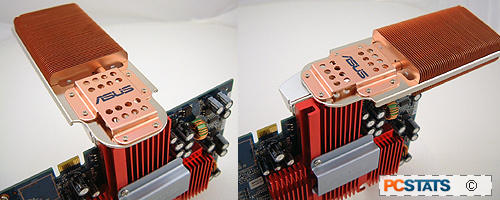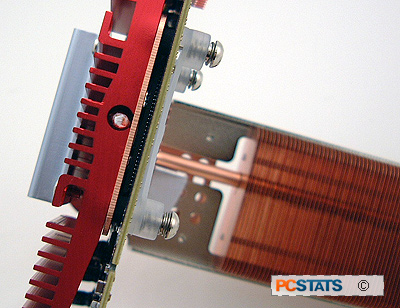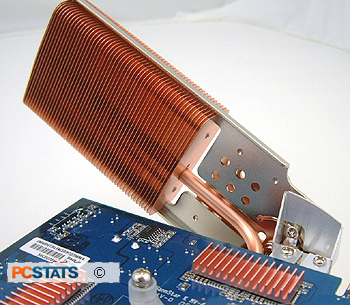 The workmanship of the
Asus SilentCool heatsink is top notch, although there are a few sharp corners that
Asus missed so be careful when handling the videocard. First the setup is a
dual slot cooling solution, (the silver Asus emblem extends down past the first expansion slot)
but then again you probably would not want to fit something under the card anyway.
The workmanship of the
Asus SilentCool heatsink is top notch, although there are a few sharp corners that
Asus missed so be careful when handling the videocard. First the setup is a
dual slot cooling solution, (the silver Asus emblem extends down past the first expansion slot)
but then again you probably would not want to fit something under the card anyway.
As you can see the front of the EN6600GT/Silencer/HTD/256M/A videocard is a large one piece aluminum heatsink which comes in contact with the heatpipe, as well as videocard memory.
On the back, we find two small aluminum heatsinks on top of the memory on the back.
Easily the neatest feature of the heatpipe cooler is its
ability to rotate 90 degrees from a vertical to horizontal position. This allows users
to position the heatpipe radiator in a spot where it can take advantage
of system airflow. The heatpipe is quite heavy so you better take care when
installing the videocard into your computer.

The
core first comes in contact with a copper heatspreader which
then transfers the heat to the heatpipe. The heatpipe then draws the
heat away from the core and moves it towards the large 52 fin copper radiator. The SilentCool
cooling solution found on the Asus EN6600GT/Silencer/HTD/256M/A is designed to work with system airflow alone. When
the copper radiator is perpendicular to the videocard, it
is designed to work with the CPU fan, sucking air
through the fins SilentCool radiator fins first before the air is used to cool the
processor.
To test the effectiveness of the Asus SilentCool passive heatsink,
the radiator was set in its vertical position which uses the CPU fan
to help draw through the fins. An 80mm Sunon fan (~35 CFM) was pointed
in its general direction and temperatures of the copper radiator fins were
42 degrees Celsius according to a Fluke 54-II digital thermometer. Core temps
hovered near the 60C mark according to RivaTuner.
Curious
to see how the Asus EN6600GT/Silencer/HTD/256M/A  would handle minimal airflow, the Sunon case fan was
disconnected and the temperature readings on the Fluke digital thermometer
started to rise. Heatsink fin temperature reached a high of
60.3C, while the GeForce 6600GT core hit a maximum temperature of 82.7C. Both temperatures
were on the high side but within acceptable operating ranges.
It is nice to see that the Asus videocard would not suffer a catastrophic
failure should the airflow stop for whatever reason.
would handle minimal airflow, the Sunon case fan was
disconnected and the temperature readings on the Fluke digital thermometer
started to rise. Heatsink fin temperature reached a high of
60.3C, while the GeForce 6600GT core hit a maximum temperature of 82.7C. Both temperatures
were on the high side but within acceptable operating ranges.
It is nice to see that the Asus videocard would not suffer a catastrophic
failure should the airflow stop for whatever reason.
Bundled software and video
enhancements
Asus has a history of bundling loads of
custom software with its videocards and the EN6600GT/Silencer/HTD/256M/A is no
different. The package comes with a whole lot of custom software; titles such as
Asus's Splendid Video enhancing technology, GameLiveShow, GameReplay, GameFace
Messenger and OnScreenDisplay.
Splendid video enhancing technology automatically adjusts the
image on the screen to be the most vibrant, be it looking at pictures
or watching videos. Splendid has four settings: Enriched, Vivid Color, Theatre and
Crystal Clear. The Enriched setting is for every day computing and it designed to
make things easier on the eyes. Vivid Color enhances the hue and saturation of
pictures which make them more lively. Theatre is designed to enhance a movie
watching experience by softening up the contrast. Lastly, Crystal Clear is
designed to enhance the contrast of darker pictures to show more
details.
GameLiveShow allows users to stream live gaming online to others, this can be
helpful for scouting clan matches of online games. Of course having a live video
connection can eat up a lot of bandwidth so only those with very fast
connections should really consider utilizing this feature. GameReplay saves games in
MPG4 video files and allow users to review and watch movies of prerecorded
games. This can be a very useful teaching or scouting tool for gamers or for
posting your own "pwn video" for your friends to marvel over.
;-) GameFace Messenger allows users to communicate to each other during
games via voice and webcam. We tested this feature back when we reviewed the
Asus V9999 Gamer Edition videocard and as you can see, it works quite well. Finally
OnScreenDisplay, allows users to adjust screen settings without having to exit
the game.
